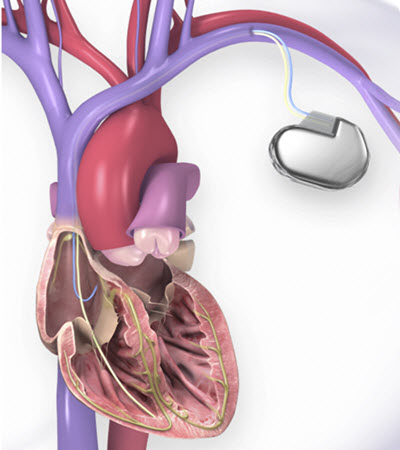Procedures
Cardiac Defibrillator Implantation
Implantable Cardiac defibrillators (ICD) implantation is a life-saving device treatment typically recommended for patients who have survived a previous sudden cardiac arrest, or have a high risk of developing life-threatening abnormal heart rhythms. arrhythmia.
This device is designed to prevent your heart from beating too fast by delivering a rapid burst of impulses or an internal shock to restore normal heart rhythm. An ICD also has the ability to pace your heart to prevent abnormally slow heart rhythms, a function similar to that of a standard pacemaker.
During the cardiac defibrillator implantation procedure ,a small device will be implanted under the skin of your chest that monitors the heart’s rhythm. If a life-threatening arrhythmia is detected, the device will deliver a shock to restore normal heart rhythm.

Call for Appointment
(02) 9646 4044
Procedures Expertise
Coronary Angiography & Stenting
Everything you need to know about
Cardiac Defibrillator Implantation
What is an implantable cardioverter defibrillator (ICD)?
An implantable cardioverter defibrillator (ICD) is a small device that is implanted under the skin of the chest to help manage life-threatening abnormal heart rhythms, such as ventricular tachycardia (VT) and ventricular fibrillation (VF).
There are two main components of an implantable cardioverter defibrillator (ICD) – the generator (battery) and one or more insulated wires. The generator contains electronic circuits and capacitors, while the wires are implanted in the heart to continuously monitor the heart rhythm.
How does an ICD work?
An ICD continuously monitors the heart rhythm and delivers electrical shocks or impulses to restore normal heart rhythm if it detects dangerous abnormal heart rhythms.
How is an ICD implanted?
An ICD is implanted through a minimally invasive procedure that typically takes 1-2 hours. The device is placed under the skin of the chest and connected to leads that are inserted into the heart.
What is the recovery process like after ICD implantation?
Most patients are able to resume their normal activities within a few days of ICD implantation, but may need to avoid certain physical activities for several weeks to allow the incision site to heal.
How long does an ICD last?
The lifespan of an ICD depends on various factors, including the device model, battery life, and individual patient factors. Most ICDs last between 5 and 10 years before requiring replacement.
Are there any restrictions on activities with an ICD?
Some physical activities, such as contact sports and heavy lifting, may need to be avoided with an ICD. Your healthcare provider can provide specific guidance on activity restrictions based on your individual situation.
Call for Appointment
(02) 9646 4044
Procedures Expertise
Coronary Angiography & Stenting
Book an Appointment
Call for appointment/GP referral
(02) 9646 4044
